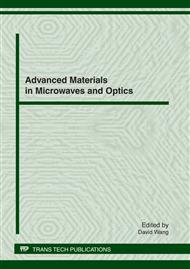[1]
F. T. Ulaby, R. K. Moore, and A. K. Fung, Microwave Remote Sensing: Active and Passive. Dedham, MA: Artech House, 1982, vol. II.
Google Scholar
[2]
Adrian F. Fung, et al. Backscattering from a randomly rough dielectric surface[J]. IEEE Trans. On Geosci. and Remote Sensing, 30(2): 356-369, (1992).
DOI: 10.1109/36.134085
Google Scholar
[3]
Tzong-Dar Wu and Kun-Shan Chen, A Reappraisal of the Validity of the IEM Model for Backscattering From Rough Surfaces[J]. IEEE TRANSACTIONS ON GEOSCIENCE AND REMOTE SENSING, VOL. 42, NO. 4, (2004).
DOI: 10.1109/tgrs.2003.815405
Google Scholar
[4]
Liu Ning, et al. Bi-Spectrum scattering model for dielectric randomly rough surface. TsingHua Science and Technology[J], 8(5): 617-623, (2003).
Google Scholar
[5]
A. -L. Germond, E. Pottier, and J. Saillard, Foundations of bistatic radar polarimetry theory, in Proc. IEE Radar Conf., Oct. 14–16, 1997, p.833–837.
DOI: 10.1201/9781420037296.ch14
Google Scholar
[6]
K. Natroshvili, O. Loffeld, H. Nies, A. M. Ortiz, and S. Knedlik, Focusing of general bistatic SAR configuration data with 2-D inverse scaled FFT, IEEE Trans. Geosci. Remote Sens., vol. 44, no. 10, p.2718–2727, Oct. (2006).
DOI: 10.1109/tgrs.2006.872725
Google Scholar
[7]
Giovanni Macelloni, Giuseppe Nesti, Paolo Pampaloni, Experimental validation of surface scattering and emission models[J]. IEEE TRANSACTIONS ON GEOSCIENCE AND REMOTE SENSING, VOL. 38, NO. 1, (2000).
DOI: 10.1109/36.823941
Google Scholar
[8]
A. Khenchaf, The bistatic scattering from the natural rough surfaces in x and ku bands, in Proc. IEEE Int. Geosci. and Remote Sens. Symp., Jul. 9–13, 2001, p.2843–2845.
DOI: 10.1109/igarss.2001.978181
Google Scholar
[9]
B. L. Matkin, J. H. Mullins, T. J. Ferster, and P. J. Vanderfold, Bistatic reflectivity measurements on various terrains at x, ku, ka, and w-band frequencies, in Proc. IEEE Radar Conf., Apr. 22–25, 2002, p.266–271.
DOI: 10.1109/nrc.2002.999730
Google Scholar
[10]
Adib Y. Nashashibi and Fawwaz T. Ulaby, MMW Polarimetric Radar Bistatic Scattering From a Random Surface[J]. IEEE TRANSACTIONS ON GEOSCIENCE AND REMOTE SENSING, VOL. 45, NO. 6, (2007).
DOI: 10.1109/tgrs.2007.894439
Google Scholar
[11]
Dobson M.C., Ulaby, F.T., Hallikainen, M.T., EI-Rayes, M.A., Microwave dielectric behaviour of wet soil part II: dielectric mixing models. IEEE Trans Geosci Remote Sciences, 1985, GE-23(1), 35-46.
DOI: 10.1109/tgrs.1985.289498
Google Scholar
[12]
A. Chanzy, B. Molineaux Impact of Filtering Soil Roughness Low Frequencies on the Radar Backscattering Coefficient Simulated by the IEM Model[J]. 0-7803-9510-7/06 (2006).
DOI: 10.1109/igarss.2006.605
Google Scholar


